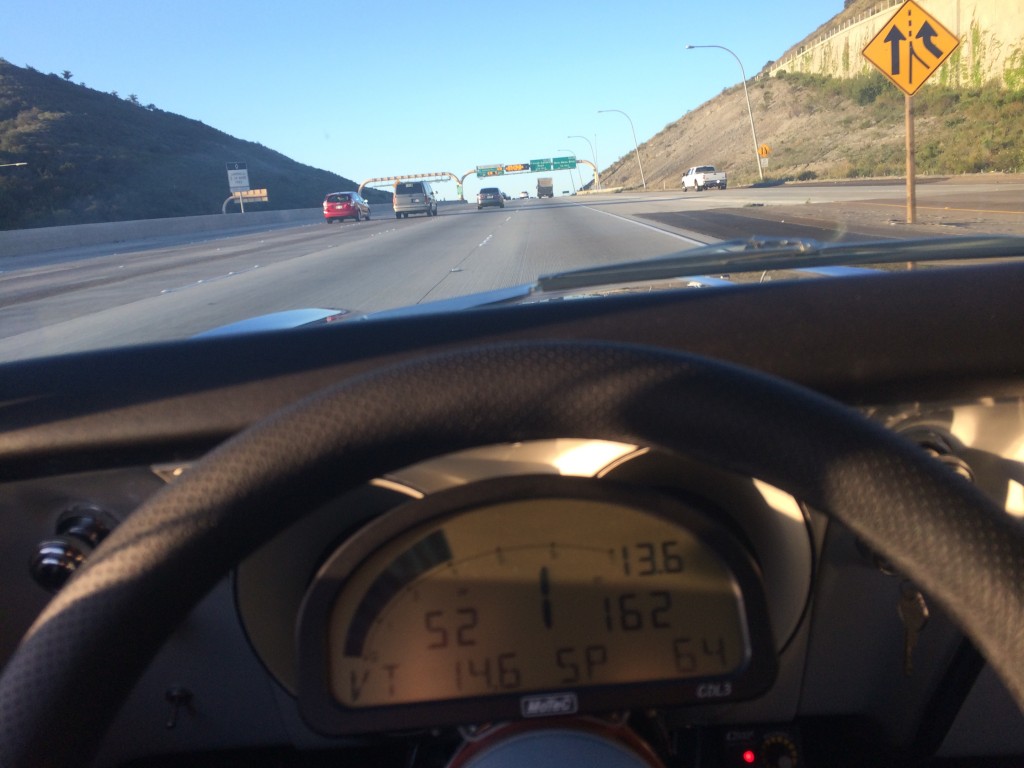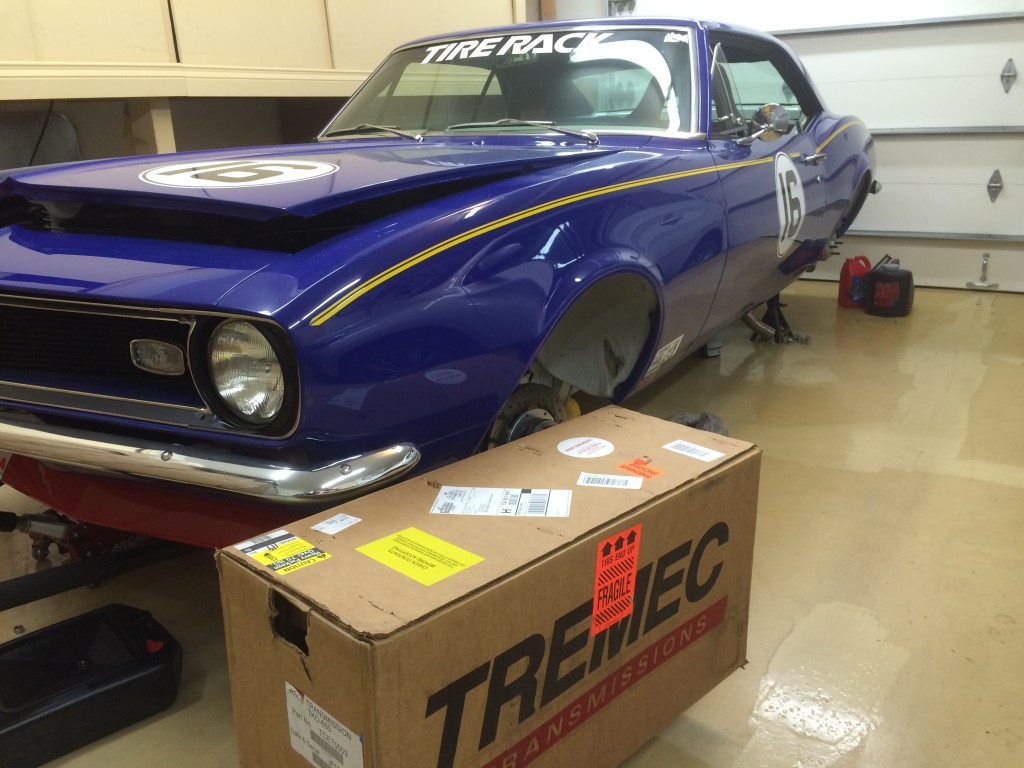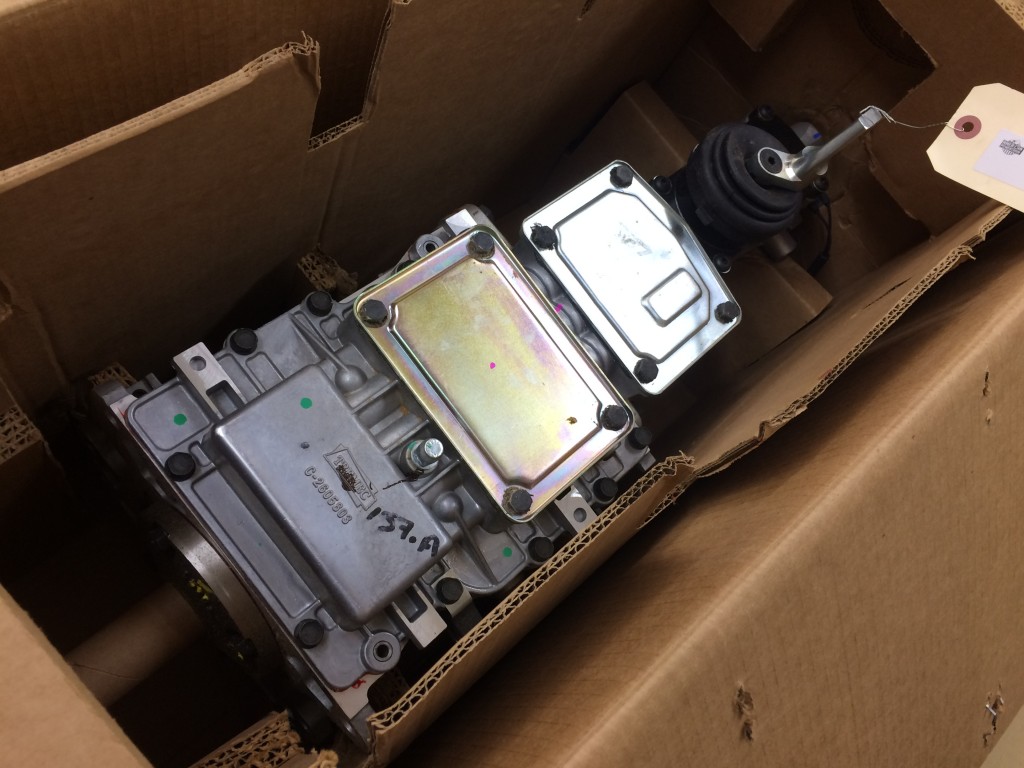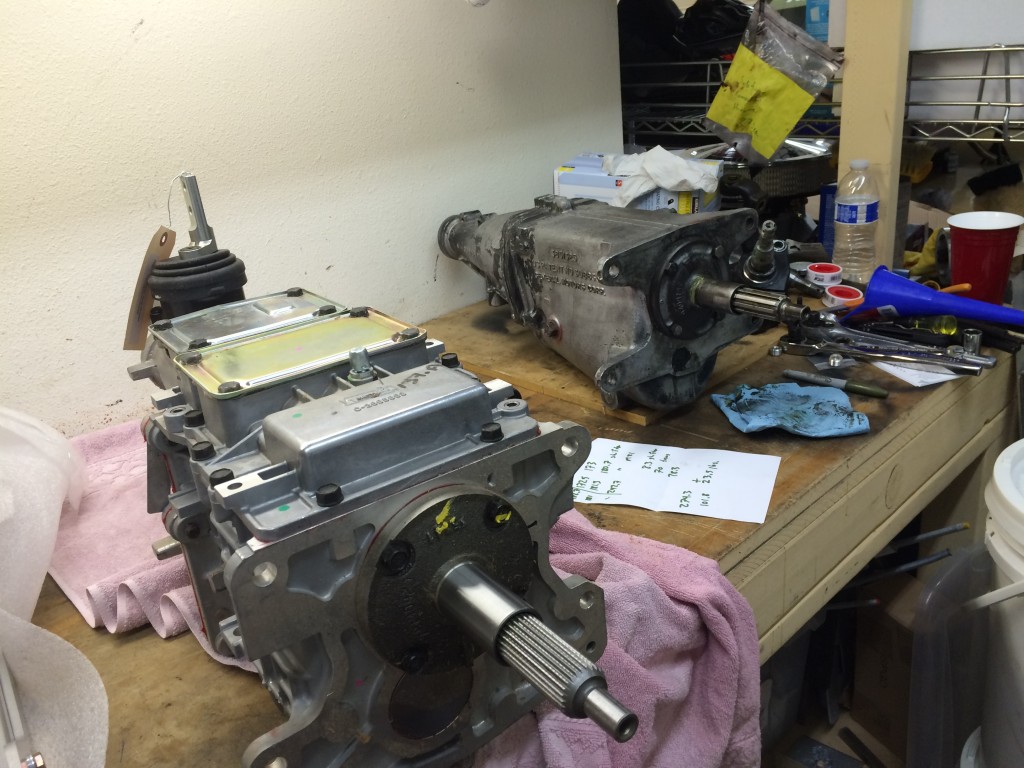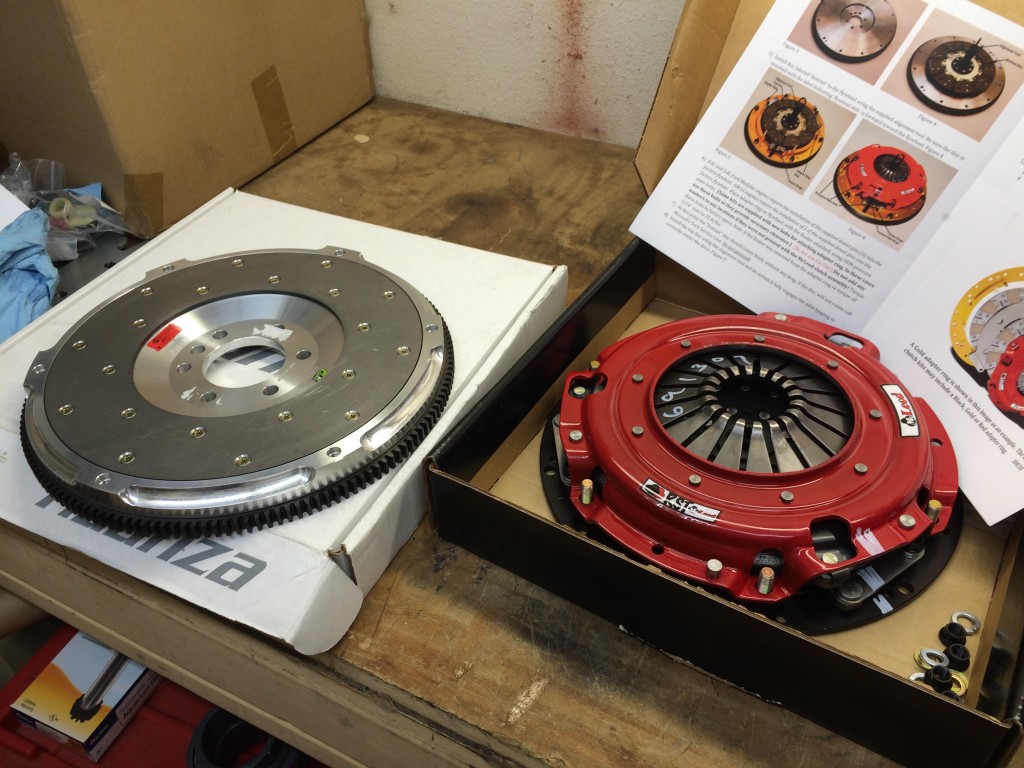Gear jammin
Back in the day, The General provided first gen Camaro owners a wide range of choices in final drive ratio. I’ve seen everything from high 2.xx’s to low 5.xx’s available as factory options.
For this thing in 2013 STX trim I went with 4.88, which netted high 60’s mph at the top of second gear with the original redline and rear tires I’d chosen. About right for an STX car. With eventually shorter rear tires and a lower redline after a lot of broken valvetrain parts, the max speed ended up in the low 60’s, not so good.
Another shortcoming revealed itself the following year when I took the car on the freeway for the first time – with the >27″ tall vintage tires, 4000rpm in top (fourth gear, 1:1), netted 62mph. Not very relaxing.
Not looking to track the car any time soon, I only had two requirements of the gearing situation:
- Produce the right top speed in second gear for autocross use
- Produce a reasonable cruising RPM for any trips on the freeway
Below is a cut from one tab of my super-duper everything-I-know-about-cars spreadsheet. Getting gearing right is important and key to understanding thrust. By messing with the stuff in green I can see the resulting outputs. Column K, 2nd Gear Max, is important to ensure your car has “long enough legs” for autocross. Column M, RPM @30mph, tells you about where the engine will be coming off the slowest of corners – especially important for peaky or boosted engines. Plugging the highest transmission ratio into the second gear column and them multiplying column M by 2-2.5, gives me a quick idea of cruise RPM.
The problem with the old school Muncies is second gear (1.64 typical) tends to be too close to top gear (always 1:1). So while 10mph per 1000rpm is perfectly reasonable for second gear (column N), with a Muncie that means you’re only getting 16.4mph per 1000rpm in top – which puts you in a situation like the above.
This is where the world kinda explodes for me. Every car I’ve monkeyed with in the last 15 years, has been done within the tight constraints of an autocross ruleset. The only exception maybe was building the 240sx for Street Mod in 2007, where sizing and building a turbo system was a ton of fun – but where I also learned that there was such a thing as too hardcore of a race car for me. Every time before and since, the rules had kept me from going too far – and in my current frame of “just don’t do anything that’s illegal in CP or CAM” – the sky is the limit.
One option would be to stick with the Muncie. To produce a good autocross gear and a decent highway gear, would mean having to autocross in first gear. For regular Solo that might kinda work but for anything with a launch it would not. The little 302 just doesn’t have the beans to get off the line with a 70+mph first gear. An 8 liter Viper with a 60mph first barely does.
Another is the Gear Vendors overdrive unit, which adapt to the Muncie and give a quick overdrive at the touch of a button. Thought about this for a while, and it might be neat in an autocross setting, to basically be able to paddle-shift up or down on course between second gear and “second-over”. The biggest concern I had with this, is the “upshift” into overdrive wasn’t instantaneous (“down”shifts out of OD are) – the engagement of overdrive is actuated by a pump on the transmission output shaft, and the faster it’s turning, the quicker the engagement. In videos where they show it engaging in first gear, there’s a delay of maybe three quarters of a second before it kicks in. That maybe doesn’t sound like a long time, but when you’re trying to time that on an autocross course, it’s an eternity. Seemed likely that it wouldn’t be totally consistent either.
The other issues were the unit is pricey (more than a good new 5 speed trans) and the overdrive is “only” .78. Better than nothing, but not as much of an overdrive as offered elsewhere. Lastly, my M21 leaked like oil was going out of style. Not an easy fix either, a worn countershaft hole in the case, the only way to repair is to drill out the hole and put in a new bushing, or buy a whole new case. So to fix the M21 and do the GV Overdrive was quickly becoming a $4k proposition
Elsewhere, there are some really beefy 4 speeds, like the Jerico transmissions commonly used in circle track racing. Common now in Street Modified and Prepared classes autocross, they are strong and light, and for this common RWD Chevy application, not that much more than some of these other options. Their non-synchronized straight cut gears sound great too. Problems there, they’re quite noisy, a bit of a pain to use on the street, and I’ve heard stories of them actually having a hard time with extended durations at light load, like cruising on the highway.
The most common swaps for these cars are Tremec 5 or 6 speeds. The 5-speed come in the TKO500 and 600 flavor (the number representative of their steady-state torque limits) and the six speed is the T56 Magnum, good for ~700.
An advantage of the T56 is you get 5 well spaced gears and a good cruising overdrive. If you want your car to stay in a narrow rpm range from 50 to 150mph, you want a 6 speed. With the 5 speed you get 1-4 similar to the 6-speed, but you have to choose whether you want your fifth gear to be like a T56’s fifth – maintaining good acceleration on a racetrack, but a bit buzzier on the highway (.82) – or more the like the T56’s 6th, where acceleration on track would be feeble, but you get a more relaxed cruise (.64).
For its superior strength and flexibility across speeds the 6-speed can’t be beat. The cost isn’t that much more either, only a few hundred bucks more than a TKO600.
There are some downsides though. First, is it’s a physically much larger transmission than the 5-speeds, which themselves are already a fair bit bigger than the 4-speed Muncies. While the TKOs can fit these old Camaros without tunnel mods, the same isn’t really the case for the T56. The other, is they’re heavy – over 130 pounds.
Long story coming to an end, I went with a TKO600. I don’t plan on acceleration above 4th gear speeds to be something I need to worry about (just don’t want to go that fast in this old thing) – and the fitment and weight benefits sealed the deal.
My motor is nowhere near 500 ft-lbs. of torque even after its planned upgrades so the TKO500 would have been fine, but the 600 was only a little bit more and should provide some future-proofing if things escalate in the future.
That paper has my notes on weight:
Stock M21 Muncie: 70lbs.
TKO600 with shifter assembly: 101lbs.
Hurst shifter assembly for Muncie: 8lbs.
So, in a heads-up comparison, the TKO is 23 lbs. heavier than the Muncie. The TKO installation kit comes with a new crossmember for mounting in the car which saves a couple pounds, for a net +21.
Last bit in this space are a new flywheel/clutch/pp. Flywheel is an aluminum Fidanza, clutch kit is a McLeod RST street twin disc. The clutch is rated to 800hp (future-proofing again!) but by virtue of being twin-disc, retains a lightweight and smooth, streetable engagement. The cost is the clutch assembly is heavy! Every pound the light flywheel saved over the OE iron piece, the clutch takes back. Oh well, at least no net gain there.
Looking forward to eliminating the biggest leak on the car, and taking the revs down to a reasonable place on the freeway. Lots more to do though!
Wrenches turning again
A vision for the Camaro’s next iteration has come into clear view, and progress has begun.
More details later – in the meantime, I’m reminded of a passage from Peter Egan I read a long time ago. His context was one of restoration vs. modification, but much of the things are the same. Though today, getting the pieces brought together is a mixture of modern online shopping with phone calls to cottage industries and folks who sometimes, were there for the heyday of the Trans-Am and Can-Am series.
Knowing all this, I paused. Walked around the car many afternoons, gazed at the dirty engine under the hood, tapped fingers on a faded fender, jingled the change in my pocket and tried to assume the bleakest possible expression of realistic hardheaded disinterest.
A car restoration, like marriage, is not to be entered into lightly. It is a fork in the road.
If we look at an old car in need and do nothing, it just sits there. The sun rises and the sun sets. Seasons come and go. The robin builds its nest, morning dew drips from a pitted chrome bumper, children grow up and need bigger shoes, and sediment in the sediment bowl turns to anthracite. A clock ticks on a wall and old men sit on a park bench and watch shadows lengthen in the town square. The car gets older, your checkbook sits on the dresser. Nothing changes.
Not restoring a car is almost the perfect embodiment of stasis. It makes a stagnant pond look like a three-ring circus.
But if you take the other fork in the road, toward restoration, everything changes: your life, your finances and the destinations of a hundred UPS trucks. It is, as Marcus Antoninus said, “like letting slip the dogs of war.”
A set of narrow whitewall tires is shipped across the country; a water pump in Cleveland gets taken off a dusty shelf by a Clevelander and sent to a Wisconsinite; telephone calls in search of superannuated oil seals crackle across a continent; a man in a Texas scrapyard pulls the front bumper off a car rear-ended when Lyndon Johnson was president; old oil comes out the bottom of an engine and new oil from new cans (for today’s higher-revving engines?) goes in the top. A bright orange oil filter spins into place, and a huge breaker bar is unlimbered from the bottom of a toolbox; Liquid Wrench flows like champagne; clean amber brake fluid courses to the car’s four corners, pushing brand-new brake shoes against freshly turned drums.
For sheer unleashed energy, it’s like one of those World War II propaganda newsreels showing American industrial workers giving Hitler a bust in the chops, everything spinning, gushing and throwing off showers of sparks. Tanks and airplanes on parade. Stand back! We are in motion here and we will not stop. We are on a holy mission and our eyes have a zealous glaze; we never sleep.
Car restoration is its own life form; the decision to go ahead and do one is a strange pivotal moment, a headlong act of resolve and suspended logic combined, like lighting the fuse for the first cannon shot at Fort Sumter.
Blow out the match and life remains simple and quiet. Maybe a little too quiet. Light the fuse and there is no peace in the world until the car is restored and rolling. In the meantime, all is glorious havoc.
